Pallet reader survey: Usage on the rise
Pallets are the foundation of the materials handling industry. Here’s why they are important to our readers.
Latest Material Handling News
Hyster recognizes Dealers of Distinction for 2023 Carolina Handling names Joe Perkins as COO Walmart deploying autonomous lift trucks at four of its high-tech DCs Kathleen Phelps to join FORTNA as chief financial officer TGW Logistics and OPEX Corporation form a strategic partnership More NewsAt any given moment in time, there are nearly 2 billion pallets on the move across the United States. New, used, metal, plastic, corrugated, wood or wood composite, pallets are, quite literally, the foundation of the materials handling industry.
For those outside of the materials handling industry, pallets might seem like a just basic commodity. But for those of us on the inside, pallets are an essential component that can have a major impact on an operation’s process and ultimately its bottom line.
“In most cases, a pallet is the platform that serves as a lynch pin for entire unit load,” says Bruce Scholnick, president of the National Wood Pallet & Container Association (NWPCA), the Washington, D.C.-based trade association that represents the wooden pallet industry. “And that platform allows you to move more in less time with less labor.”
Pallets have the power to affect major cost savings for manufacturers and any operation moving product. They also protect the product during transit and allow it to arrive at its destination in good, usable, salable condition. Without a pallet, a product’s packaging would have to be more durable, which could also translate into higher costs.
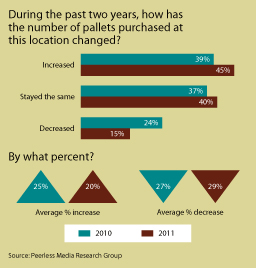 So, since almost every product moving through our nation’s supply chain moves on a pallet, the question is: What type of pallet and why?
So, since almost every product moving through our nation’s supply chain moves on a pallet, the question is: What type of pallet and why?
Actually, there are a lot more questions in our annual pallet survey, which was resurrected last year after eight years and a lot of industry evolution. Modern’s goal in conducting the pallet survey is to better understand current and future usage of pallets as well as any trends that may be occurring in the pallet market.
In August, Modern’s 2011 Pallet Survey was sent out to subscribers of our magazine as well as a sample of recipients or our e-newsletters. The e-mail invitation also included a URL linked to a dedicated Web site that contained the questionnaire. We received 594 qualified responses from readers employed at a facility that actually uses pallets. The survey has a margin of error of ±5.6%.
Here’s what the readers told us.
People purchasing pallets
The people who responded to Modern’s pallet survey once again represent a broad spectrum of industry verticals, with food and beverage (16%), consumer goods (12%), wholesale trade (10%), and transportation and warehousing (8%) accounting for nearly half (46%) of the qualified responses. We also received responses from a number of other sectors, including paper and allied products, medical and healthcare products, electronics, automotive, building materials, metals and aerospace, to name a few.
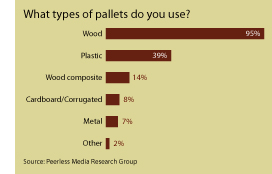 The average reader is purchasing an estimated 9,020 pallets at their location, or roughly 18 truckloads a year, slightly below 20 truckloads a year reported in 2010. However, 14% of users are purchasing more than 30,000 or more pallets a year, or about five truckloads per month or more. Another 16% are purchasing between 10,000 and 29,000 pallets per year at their location.
The average reader is purchasing an estimated 9,020 pallets at their location, or roughly 18 truckloads a year, slightly below 20 truckloads a year reported in 2010. However, 14% of users are purchasing more than 30,000 or more pallets a year, or about five truckloads per month or more. Another 16% are purchasing between 10,000 and 29,000 pallets per year at their location.
While there is a lot of talk about the stagnant economy, pallets are generally an indication of the amount of product being palletized for inventory or shipping purposes. Yet, 45% of respondents indicated that their pallet usage has increased over the last two years, by an average of 20% and another 40% indicated their pallet usage had remained the same. Only 15% of respondents indicated their usage had gone down, by an average of 29%.
We found similar results looking forward. Asked how they believe the number of pallets they purchase will change over the next two years, 48% expect to increase their pallet purchases, by an average of 17% and 43% expect their purchases to remain the same. Only 9% expect their pallet purchases to decrease, by an average of 31%.
According to this year’s survey, 60% of the pallet purchasing decisions continue to be made by purchasing managers, warehouse managers, shipping and warehouse managers, and dedicated buyers. And, as was also the case last year, the majority of pallets (52%) are being purchased at the local level, meaning people at that location are buying pallets for that location only. Fifteen percent of respondents say that pallets are purchased at the local level for that site plus others, and 18% say that their pallets are purchased at the division-level for one or a number of locations.
A pallet’s purpose
So, once purchased, what’s the purpose of these pallets? For the most part (83%), pallets are being used in both warehousing and shipping applications. Only 8% of our readers report using pallets solely for warehousing and 9% solely for shipping.
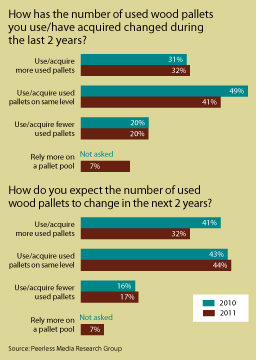 Of the pallets being used in a shipping capacity, 40% say that their pallets are used to export product; 59% send their pallets on a one-way journey out to trading partners; and 20% circulate pallets in a closed-loop between trading partners.
Of the pallets being used in a shipping capacity, 40% say that their pallets are used to export product; 59% send their pallets on a one-way journey out to trading partners; and 20% circulate pallets in a closed-loop between trading partners.
Seventy-one percent of readers say that their pallets move in a closed-loop transporting product and materials within their facility, and 52% say pallets move between a number of facility locations with their organization.
One example of the latter is the Chicago Transit Authority. It owns thousands of wooden pallets that are used to move materials from its central warehouse out to 20 maintenance locations. Pallets are on the job around the clock moving materials needed to repair buses and trains and support its stations. “We have about 60,000 SKUs in stock,” explains Mark Ehmig, general manager of warehouse operations. “Everything from plumbing and electrical supplies is moved internally on our own pallets.”
Pallets can live a long, useful life in this closed-loop, even those that get pretty grimy. “There’s a small number, about 5%, that we use to handle items that don’t need to be moved on clean, pristine pallets,” says Ehmig. “Some of these pallets have seen better days, but they’re still useful.”
That’s not true in all cases. For example, the White Castle facility in Covington, Ky., which makes frozen food for the White Castle burger chain, has to address a number of strict requirements when handling food, including those issued by the Grocery Manufacturers Association (GMA).
As a result, the White Castle facility incorporates a number of pallet solutions. For example, warehouse supervisor Gordon Skaggs explains that since products cannot be placed directly on a floor, they use their own wooden pallets to store and hold products. Plastic pallets serve a role in carrying onions through the preparation process because, as Skaggs says, onions get sticky and plastic pallets are washable.
When it comes time to ship the frozen food out to restaurants, distributors show up at White Castle’s shipping dock equipped with their own pallets. “We use different carriers and they all come for the product with their own pallets,” says Skaggs. “They come with about 30 pallets, and it’s an even pallet exchange.”
Stable business
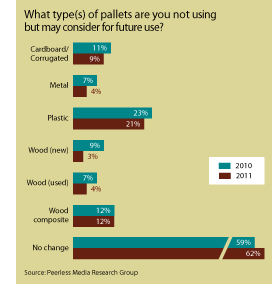 How respondents are using pallets this year tracks closely with last year’s findings. In fact, according to Modern’s research team, the differences are not statistically significant. Meaning, the overall numbers in this year’s pallet survey tell us that the pallet industry has been stable. There is little change from last to this year.
How respondents are using pallets this year tracks closely with last year’s findings. In fact, according to Modern’s research team, the differences are not statistically significant. Meaning, the overall numbers in this year’s pallet survey tell us that the pallet industry has been stable. There is little change from last to this year.
However, our survey did uncover a slight variation in the average number of times a pallet is used. Last year, the average number of times a pallet was used was 7.5. This year, the average dropped to 5.6.
There could be a number of factors responsible for the decline, explains NWPCA’s Scholnick. For example, business could have fallen off for some respondents, or some respondents might be storing product on “slave” pallets in a warehouse. But Scholnick also says this slight adjustment is not a red flag. There are a host of reasons the number has gone down, but the pallet industry is cyclical and that number is going to fluctuate, he says.
Pallet rental
Another interesting point that came to light in this year’s pallet survey is the increase in those considering certain pallet rental systems.
Last year, 48% of our respondents using pooled pallets were managing their own pools. This year, that number is down to 35%, and respondents say they are considering a helping hand. (Interestingly enough, readers tell us that the top reasons for outsourcing pallet handling and repair are the same reasons for keeping it in house - cost effectiveness and convenience.)
 Modern’s survey included a number of companies that lease, repair or manage pallet pools, including CHEP, IFCO, PECO, iGPS and Ongweoweh. Among them, CHEP saw interest and/or participation in their business jump from 22% last year to 43% this year. While the increase wasn’t as dramatic for the others, up is up.
Modern’s survey included a number of companies that lease, repair or manage pallet pools, including CHEP, IFCO, PECO, iGPS and Ongweoweh. Among them, CHEP saw interest and/or participation in their business jump from 22% last year to 43% this year. While the increase wasn’t as dramatic for the others, up is up.
One reason for the increased interest could be due in part to new guidelines issued by big box retailer Costco. Last year, the company mandated that all by the end of 2010, all deliveries must arrive on a four-way entry block style pallet. This style of pallet has a true four-way entry that makes it easier to unload and handle the unit load, which ultimately enhances efficiencies. However, it’s more challenging to manufacture than the basic stringer style pallet and also more expensive.
So, rather than buy more expensive pallets, end users are considering the jump into a pallet rental pool with pallets like those offered by CHEP, PECO and iGPS. This option could provide cost savings for some operations and ease the constant pressure to lower expenses by collaborating with vendors who can become partners and focus on part of the operation that is not directly connected with its core competency. Simply put, as one respondent said, “We are not in the pallet repair business.”
But some companies are in the pallet repair business, which is good news to nearly two-thirds of survey respondents. Of the readers using wooden pallets, 60% use a third party or pallet recycler to maintain their pallets, while 28% sort and repair their pallets internally.
Wood wins, plastic places
Regardless of who is maintaining the pallets, it’s clear that wood continues to be the overwhelmingly dominant material of choice in the market, with 95% of respondents reporting that they use wooden pallets at their facility.
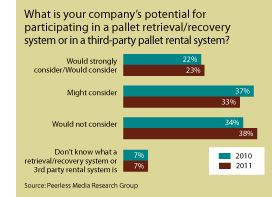 And within that figure, according to Scholnick, about 80% of the wooden pallets in circulation today are reused. Over the past two years, 32% of respondents say they have acquired more used wooden pallets, and that same number has plans to acquire more used wooden pallets for their operation. Only 17% report an expectation of using fewer used wooden pallets in the next two years.
And within that figure, according to Scholnick, about 80% of the wooden pallets in circulation today are reused. Over the past two years, 32% of respondents say they have acquired more used wooden pallets, and that same number has plans to acquire more used wooden pallets for their operation. Only 17% report an expectation of using fewer used wooden pallets in the next two years.
While wood is the winner, plastic is gaining some traction. Thirty-nine percent of our readers say that they use some plastic pallets at their location, compared to last year’s 33% who said they use some plastic pallets. And, of those not currently using plastic, 21% say they would consider using plastic pallets in the future.
When considering wood pallets, readers told us the most important considerations continue include the following: purchase price (95%), strength (95%), availability (93%), and durability (92%).
However, when considering plastic, priorities have shifted. Last year, strength and durability were the top priorities (92% each). This time around those factors are still the top considerations, but they are less important (83% and 82%, respectively) to end users.
Weighing into a location’s pallet choice can be a number of factors, including sanitary issues, durability and quality. “We would only change to reduce cost but probably would not change from plastic,” explains one respondent. “We have found the plastic pallets give us the highest number of turns, literally measured in years of service with as many as five or six trips per week.”
Among the other materials highlighted in the survey, 14% of respondents indicate they use some wood composite pallets, 8% say they use some cardboard/corrugated, and 7% say they use some metal pallets. Respondents, however, did not indicate in what quantities alternative pallets are purchased.
But, of course, every pallet has a unique purpose. For example, corrugated or transport pallets are designed for one-time use, often going from a manufacturing operation to a distribution center where product is repalletized and stored. And, although more expensive, aluminum pallets are lightweight and strong which makes them ideal for transport in the airline industry.
Every operation is different and pallet usage depends on what and where product is moving. But according to Scholnick, “All pallets have place in the market.”

Article Topics
Latest in Materials Handling
Hyster recognizes Dealers of Distinction for 2023 Carolina Handling names Joe Perkins as COO C-suite Interview with Keith Moore, CEO, AutoScheduler.AI: MODEX was a meeting place for innovation Walmart deploying autonomous lift trucks at four of its high-tech DCs Coles shops big for automation Kathleen Phelps to join FORTNA as chief financial officer Coles automates grocery distribution in Australia More Materials HandlingAbout the Author
Subscribe to Materials Handling Magazine

Find out what the world's most innovative companies are doing to improve productivity in their plants and distribution centers.
Start your FREE subscription today.
April 2024 Modern Materials Handling

Latest Resources











